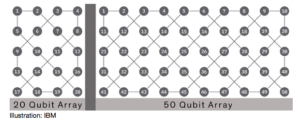Ok we are officially off topic and hopefully not pushing the bounds of DD publisher, Bob Raikes beyond his tolerance for non-display coverage… That said, for me the most compelling and yes perhaps long lasting technology at this year’s CES was arguably shown in the Venetian A – B directly across from the CES innovation awards showcase.

Here. IBM Watson research parked not only its Jeopardy game show champion, the namesake Watson supercomputer, but also the company’s newest technology breakthrough, the recently announced IBM 50-qubit quantum processor. It was perhaps the first time that the Watson supercomputer team has had to take second billing!
IBM Watson research scientist, Dr. Ken Rodbell, told us the “Q” as they lovingly call it, is already in operation and available for partner testing on the IBM Q network using a 20-qubit capacity machine, that increases its processing power exponentially with each additional connected qubit added.
IIBM Interconnected Quantum bit configuration expands processing exponentially with each additional qubit, Source IBM
Details of the IBM Quantum computer shown at CES 2018, with cooling system that keeps the temperature at close to absolute zero, Source: Sechrist
The trick in outshining supercomputers like Watson is to demonstrate computational supremacy or what a team of Google researchers have dubbed “quantum supremacy”. Researchers reckon supremacy over conventional super computer processing power can be achieved by quantum computers with access to just 50 interconnected “qubits” (short for quantum bit).
IBM Quantum Computer shown at CES 2018, Source: Sechrist
This new approach to data processing leverages quantum mechanics to run new types of algorithms that Rodbell told us take more time setting up than the actual computation which is usually close to instantaneous. Researchers will essentially “…test all numbers against a problem at once, and in parallel,” according to IBM lab director Jeff Weiser, at the computer’s first announcement in November 2017 and reported by IEEE Spectrum. To get there, researchers have been working to extend the “coherence time” that is, the read time a system can use before the fragile qubit decays.
Qubits vs Bits
Qubits exist in a dual state of 0 and 1 simultaneously, what researchers call a “superposition of states” that grows exponentially as the number of interconnection of qubits increases. Two interconnected qubits can represent 4 numbers three qubits 8 numbers and so on. A fifty qubit interconnected system will represent 10,000,000,000,000,000 numbers, that would overwhelm a classic computer’s memory and require more than a petabyte of storage to capture.
So by leveraging the principles of quantum physics, we move towards the next frontier in human understanding. There is the promise of a new advent in computing with power and speed to expand processing beyond any level yet achieved and we are witnessing the beginning of the quantum computing era. This may also usher in a deeper understanding of a phenomenon that has perplexed our greatest minds, i.e. observations of quantum entanglement (Einstein’s “spooky action at a distance”) with the untold benefits for us all. – Stephen Sechrist

